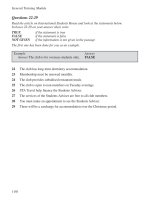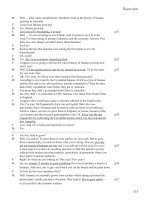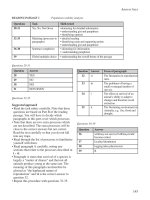Cambridge Practice Tests for IELTS part 7
Bạn đang xem bản rút gọn của tài liệu. Xem và tải ngay bản đầy đủ của tài liệu tại đây (865.17 KB, 15 trang )
85
Rreading
encouraging for women, in that they send
a positive message to them to apply for
interesting management positions. But
she added, “We should not lose sight of
the fact that significantly fewer women
apply for senior positions in comparison
with men.”
C Reasons for higher success rates among
women are difficult to isolate. One
explanation suggested is that if a woman
candidate manages to get on a shortlist,
then she has probably already proved
herself to be an exceptional candidate.
Dr Marx said that when women apply
for positions they tend to be better
qualified than their male counterparts but
are more selective and conservative in
their job search. Women tend to research
thoroughly before applying for positions
or attending interviews. Men, on the
other hand, seem to rely on their ability
to sell themselves and to convince
employers that any shortcomings they
have will not prevent them from doing a
good job.
D Managerial and executive progress made
by women is confirmed by the annual
survey of boards of directors carried out
by Korn/Ferry/Carre/ Orban
International. This year the survey shows
a doubling of the number of women
serving as non-executive directors
compared with the previous year.
However, progress remains painfully
slow and there were still only 18 posts
filled by women out of a total of 354 non-
executive positions surveyed. Hilary
Sears, a partner with Korn/Ferry, said,
“Women have raised the level of grades
we are employed in but we have still not
broken through barriers to the top.”
E In Europe a recent feature of corporate
life in the recession has been the de-
layering of management structures.
Sears said that this has halted progress
for women in as much as de-layering has
taken place either where women are
working or in layers they aspire to. Sears
also noted a positive trend from the
recession, which has been the growing
number of women who have started up
on their own.
F In business as a whole, there are a
number of factors encouraging the
prospect of greater equality in the
workforce. Demographic trends suggest
that the number of women going into
employment is steadily increasing. In
addition a far greater number of women
are now passing through higher
education, making them better qualified
to move into management positions.
G Organisations such as the European
Women’s Management Development
Network provide a range of
opportunities for women to enhance
their skills and contacts. Through a series
of both pan-European and national
workshops and conferences the barriers
to women in employment are being
broken down. However, Ariane Berthoin
Antal, director of the International
Institute for Organisational Change of
Archamps in France, said that there is
only anecdotal evidence of changes in
recruitment patterns. And she said, “It”s
still so hard for women to even get on to
shortlists -there are so many hurdles and
barriers.’ Antal agreed that there have
been some positive signs but said “Until
there is a belief among employers, until
they value the difference, nothing will
change.”
86
Example Answer
The salary range studied in the NB Selection survey. B
Practice Test 4
Questions 14-19
Reading Passage 2 has 7 paragraphs (A-G). State which paragraph discusses each of the
points below. Write the appropriate letter (A-G) in boxes 14-19 on your answer sheet.
14 The drawbacks of current company restructuring patterns.
15 Associations that provide support for professional women.
16 The success rate of female job applicants for management positions.
17 Male and female approaches to job applications.
18 Reasons why more women are being employed in the business sector.
19 The improvement in female numbers on company management structures.
Questions 20-23
The author makes reference to three consultants in the Reading Passage. Which of the list of
points below do these consultants make? In boxes 20-23 write
M if the point is made by Dr Marx
S if the point is made by Hilary Sears
A if the point is made by Ariane Berthoin Antal
20 Selection procedures do not favour women.
21 The number of female-run businesses is increasing.
22 Male applicants exceed female applicants for top posts.
23 Women hold higher positions now than they used to.
Questions 24-27
Using NO MORE THAN THREE WORDS answer the following questions. Write your
answers in boxes 24-27 on your answer sheet.
24 What change has there been in the number of women in top management positions
detailed in the annual survey?
25 What aspect of company structuring has disadvantaged women?
26 What information tells us that more women are working nowadays?
27 Which group of people should change their attitude to recruitment?
87
Reading
READING PASSAGE 3
You should spend about 20 minutes on Questions 28-39 which are based on Reading Passage
3 below.
Population viability analysis
Part A
To make political decisions about the extent and type of forestry in a region
it is important to understand the consequences of those decisions. One tool
for assessing the impact of forestry on the ecosystem is population viability
analysis (PVA). This is a tool for predicting the probability that a species
will become extinct in a particular region over a specific period. It has been
successfully used in the United States to provide input into resource
exploitation decisions and assist wildlife managers and there is now enormous
potential for using population viability to assist wildlife management in
Australia’s forests.
A species becomes extinct when the last individual dies. This observation is
a useful starting point for any discussion of extinction as it highlights the
role of luck and chance in the extinction process. To make a prediction about
extinction we need to understand the processes that can contribute to it and
these fall into four broad categories which are discussed below.
Part B
A Early attempts to predict population viability were based on demographic
uncertainty Whether an individual survives from one year to the next
will largely be a matter of chance. Some pairs may produce several young
in a single year while others may produce none in that same year. Small
populations will fluctuate enormously because of the random nature of
birth and death and these chance fluctuations can cause species extinctions
even if, on average, the population size should increase. Taking only this
uncertainty of ability to reproduce into account, extinction is unlikely if
the number of individuals in a population is above about 50 and the
population is growing.
B Small populations cannot avoid a certain amount of inbreeding. This is
particularly true if there is a very small number of one sex. For example,
if there are only 20 individuals of a species and only one is a male, all
future individuals in the species must be descended from that one male.
For most animal species such individuals are less likely to survive and
reproduce. Inbreeding increases the chance of extinction.
88
Practice Test 4
C Variation within a species is the raw material upon which natural selection
acts. Without genetic variability a species lacks the capacity to evolve and
cannot adapt to changes in its environment or to new predators and new
diseases. The loss of genetic diversity associated with reductions in
population size will contribute to the likelihood of extinction.
D Recent research has shown that other factors need to be considered.
Australia’s environment fluctuates enormously from year to year. These
fluctuations add yet another degree of uncertainty to the survival of many
species. Catastrophes such as fire, flood, drought or epidemic may reduce
population sizes to a small fraction of their average level. When allowance
is made for these two additional elements of uncertainty the population
size necessary to be confident of persistence for a few hundred years may
increase to several thousand.
Part C
Beside these processes we need to bear in mind the distribution of a population.
A species that occurs in five isolated places each containing 20 individuals
will not have the same probability of extinction as a species with a single
population of 100 individuals in a single locality.
Where logging occurs (that is, the cutting down of forests for timber) forest-
dependent creatures in that area will be forced to leave. Ground-dwelling
herbivores may return within a decade. However, arboreal marsupials (that is
animals which live in trees) may not recover to pre-logging densities for over
a century. As more forests are logged, animal population sizes will be reduced
further. Regardless of the theory or model that we choose, a reduction in
population size decreases the genetic diversity of a population and increases
the probability of extinction because of any or all of the processes listed above.
It is therefore a scientific fact that increasing the area that is loaded in any
region will increase the probability that forest-dependent animals will become
extinct.
89
Reading
Questions 28-31
Do the following statements agree with the views of the writer in Part A of Reading
Passage 3? In boxes 28-31 on your answer sheet write
YES if the statement agrees with the writer
NO if the statement contradicts the writer
NOT GIVEN if it is impossible to say what the writer thinks about this
Example Answer
A link exist between the consequences of decisions and
the decision making process itself. YES
28 Scientists are interested in the effect of forestry on native animals.
29 PVA has been used in Australia for many years.
30 A species is said to be extinct when only one individual exists.
31 Extinction is a naturally occurring phenomenon.
Questions 32-35
These questions are based on Part B of Reading Passage 3.
In paragraphs A to D the author describes four processes which may contribute to the
extinction of a species. Match the list of processes (i-vi) to the paragraphs. Write the
appropriate number (i-vi) in boxes 32-35 on your answer sheet.
NB There are more processes than paragraphs so you will not use all of them.
Processes
i Loss of ability to adapt
ii Natural disasters
iii An imblance of the sexes
iv Human disasters
v Evolution
vi The haphazard nature of
reproduction
32 Paragraph A
33 Paragraph B
34 Paragraph C
35 Paragraph D
90
Questions 36-38
Based on your reading of Part C, complete the sentences below with words taken from the
passage. Use NO MORE THAN THREE WORDS for each answer. Write your answers in
boxes 36-38 on your answer sheet.
While the population of a species may be on the increase, there is always a
chance that small isolated groups ... (36) ...
Survival of a species depends on a balance between the size of a population
and its ... (37) ...
The likelihood that animals which live in forests will become extinct is
increased when ... (38) ...
Question 39
Choose the appropriate letter A-D and write it in box 39 on your answer sheet.
39 An alternative heading for the passage could be:
A The protection of native flora and fauna
B Influential factors in assessing survival probability
C An economic rationale for the logging of forests
D Preventive measures for the extinction of a species
Practice Test 4









